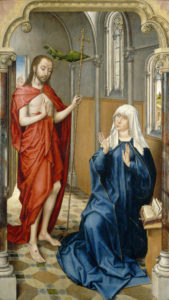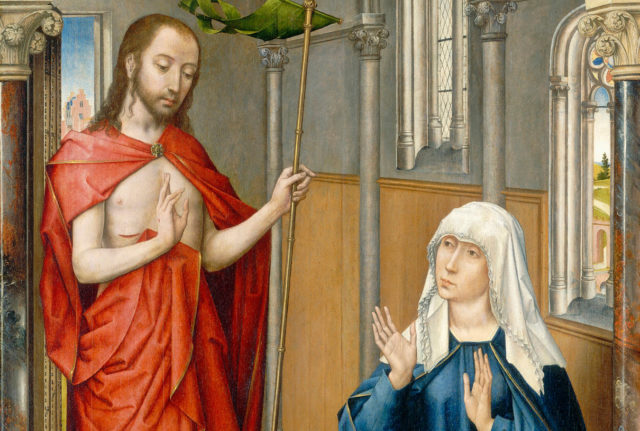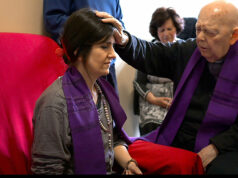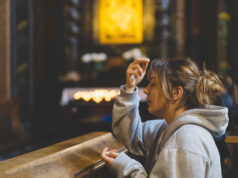Things that go bump in the night hold an eerie fascination — even for Catholics. People love to be mystified by what defies an earthly explanation. At primary school, Felicity, a girl in my class, lived in what she said was a haunted house. She held us spellbound with tales of objects moving. She didn’t see them move, but she insisted that they moved! She said she wasn’t at all frightened by the strange happenings.
At college I met Angela. Her family home was in an old barracks, and she fascinated us with tales of the “lady in gray” who turned up from time to time in the house. Most often she was spotted at the turn of the stairs.
One night Angela woke up and the lady was standing at the end of the bed, she told us. We held our breaths as she went on. “I thought it was my mum, but when I asked her the next morning what she had been doing standing there she told me it wasn’t her.”

A little ripple of horror and excitement went through her listeners, including me. We were chilled with the tales of the otherworldly occurrences.
But it made me think, Who are these troubled souls? It seems that as Catholics we’re not exempt from seeking an answer or sharing a fascination for events that defy natural explanation — what some call the “paranormal.”
Father Brendan Purcell, a philosopher and writer in Dublin, says the Catholic Church does not have an official view on things such as haunted houses or other things that defy natural explanation. They can happen to anyone, after all.
On a visit to the Isle of Wight, Father Purcell recalls that his father visited a house where he had an “awful sensation” and subsequently found that it had been the scene of gruesome murders hundreds of years earlier.
If we look at church teaching, we see that some things that are hard to understand, because we can’t see them, are explained. Church teaching says that when it comes to a person dying, for example, death means the body is dead but the spirit lives on.
And it also tells us what not to do when curiosity gets the better of us. “What the church does say is never to try to get in touch with spirits,” Father Purcell said.
The catechism, the touchstone of our beliefs, addresses such things as practices of magic and sorcery. Clearly these things are wrong.
Other things that mystify us as Catholics include some of our teachings, including purgatory, which means “purification.” But again, our trusted teacher, the catechism, and other teachers of the faith, can help explain when we fail to grasp the meaning of a mystery.
A modern mystic, Chiara Lubich, described purgatory using the image of a fiancee waiting for her beloved to come to take her to the opera. She does not want to come down to him yet because she is still getting ready.
Even the idea of hell can mystify some of us. In “The Brothers Karamazov” by Fyodor Dostoevsky, a character in the novel, a monk, describes hell as the suffering of those who do not want to love.
Father Purcell shares a similar view. “There is an awareness that love is what we are built for but we are unable to love. That is hell,” Father Purcell said.
In that realm of darkness, the Catechism of the Catholic Church says that the power of Satan is not infinite, but limited.
A Spanish demonologist/exorcist, Father Jose Antonio Fortea writes that demons or the devil can tempt people but they are not able to read people’s thoughts.
“Only God can read our soul,” said Irish Bishop Brendan Leahy of Limerick.
Pope Francis speaks regularly of the devil. “The devil is here … even in the 21st century!” he said in April 2014. “We must learn from the Gospel how to fight against Satan.” But he insists that Christ will guard the church from Satan.
And heaven?
In 2 Peter 3:13, St. Paul talks of “new heavens and new earths.” Christian theology believes firmly in not just a spiritual world but a physical world, too.
“It’s hard to believe that heaven would be without animals, plants, sunshine, music, dancing, all sorts of science fiction stuff, like the ability to travel to other galaxies. Jesus was able to walk through walls,” Father Purcell said. “But, first of all, it would be a consciousness that once we understand what love is, you never get tired of loving.”
While on earth, with strife and conflicts, it is hard for us to understand a world in which none of that exists. The best we can imagine, when it comes to heaven, is that it’s similar to a sensation of being in love.
“Think of your first love, and you are walking on air. But it is not limited to any one person, but it is an experience of this profound unity with everyone in the human family, and with them, the Father, Son and Holy Spirit,” Father Purcell said.
— By Susan Gately, Catholic News Service
Gately is a writer from Dublin.








